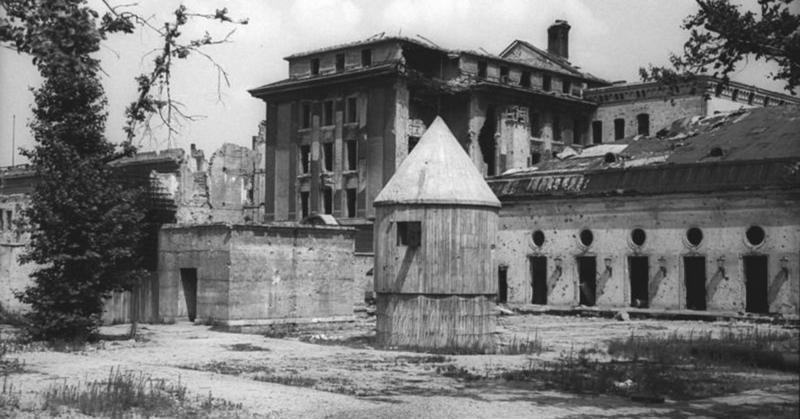Hitler's Last Day: Everything We Know About His Bunker Suicide
By | April 28, 2020

On this day in 1945, a shot rang out in a Berlin bunker that would signify the end of one of the most horrific eras of human history. After rising through the political ranks, Adolf Hitler became the chancellor of Germany in 1933, solidifying the Nazi Party's control over the economically struggling nation. Hitler used the people's desperation to seize power and carry out not only the single deadliest war to date but also the largest genocide mankind has ever known. With 70 million dead as a result of World War II, innumerable people wanted Hitler's head by April 30, 1945. A villain to the end, he took himself out before any of them had the chance.

Hitler's Bunker
It all went down in an air raid shelter known as the Führerbunker, a vast concrete complex designed specifically to protect the chancellor if Berlin was invaded or bombed. By late 1944, the war in the European theater was all but lost as Allied forces reclaimed more and more German-occupied territory and the Nazis suffered heavier and heavier casualties. The despot became so desperate that he began sending children as young as 12 and men as old as 60 to the front lines, but with the Soviets taking Poland and the Americans closing in on Berlin, even someone as delusional as Hitler couldn't help but see the writing on the wall. He retreated to the bunker in January 1945 and never came out again. Not alive, anyway.
Berlin's protection ended on April 19, when Soviet forces took out a major chunk of the German front line during the Battle of Seelow Heights. Hitler became so despondent after learning that his commanders were no longer obeying his orders and Fascism founder Benito Mussolini had died that he asked his doctor for cyanide capsules on April 22.

Love Before Death
Hitler no doubt saw his future in the grisly death of Benito Mussolini. The Italian dictator and his mistress had been dragged by his own people into the village square of a town near the border, where they had attempted to flee the country, to be executed by machine gun and left for the people to abuse until their bodies were totally unrecognizable. If Hitler was to die, he wanted to at least feign dignity.
His first order of business was surprisingly sentimental. As American forces liberated the Dachau concentration camp on April 29, Hitler arranged a small ceremony to marry his longtime mistress, 33-year-old Eva Braun. According to the Führer's housekeeper, Braun had wanted to marry Hitler for the better part of a decade and once even shot herself in the chest after he refused. Interestingly but perhaps not surprisingly, four of Hitler's girlfriends either attempted or died by suicide over the course of his life.

A Monster To The End
After the civil ceremony, Hitler confided to his secretary, Traudl Jung, his last will and testament, which he used as an excuse to lay out his resentment toward the Jewish people one last time before asking to be cremated and offering all of his valuable property to the soon-to-be-defunct Nazi Party. Even as he knew all was lost, Hitler couldn't bear to relinquish control, so he ordered the arrest and execution of the subordinates who were attempting to negotiate the inevitable surrender.
As he said his individual goodbyes to his friends and colleagues, he asked his doctor to test the strength of the cyanide capsules on his devoted dog, Blondi. The poor pup died shortly thereafter. It's the most basic rule of action movies and thus society—"never kill the dog"—but even as he wound down his life, Hitler couldn't follow it. Finally, at around 3:00 P.M. on April 30, 1945, the newlyweds retreated into their study, where they both took the cyanide capsules. In an abundance of caution, Hitler also shot himself in the head. Their bodies were then taken to the garden, covered with a Nazi flag, and set on fire.

Ding-Dong, The Nazi's Dead
The bodies of Adolf Hitler and Eva Braun were found by Soviet soldiers just days after their deaths, the charred remains only identifiable with the help of Hitler's dental records. Understandably, many refused to take the Soviets at their word, and over the years, numerous supposed sightings of Hitler have been reported throughout Europe and South America. The most common conspiracy theory is that Hitler escaped the bunker and somehow made it through Berlin and the rest of Europe before taking refuge in Argentina, as many other lower-ranking Nazis had managed to do. This is highly unlikely, seeing as Hitler was probably the most famous man in the world and the considerably less recognizable Mussolini couldn't even make his way out of Italy without being spotted and dragged to his death.
Rumors of escape were finally put to rest in the 1970s, when the Soviets handed over Hitler's jaw to the French, who conducted their own thorough investigation and concluded that the teeth and dentures were, in fact, those of the disgraced former chancellor. Although the Russians still retain Hitler’s jaw and skull as historical evidence, the rest of his body was properly cremated and discarded either in or around the Biederitz River to prevent future Fascist sympathizers from paying homage to the tyrant's grave.

